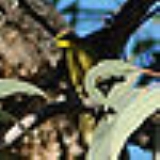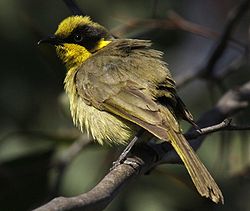
Yellow-tufted Honeyeater
Encyclopedia

Passerine
A passerine is a bird of the order Passeriformes, which includes more than half of all bird species. Sometimes known as perching birds or, less accurately, as songbirds, the passerines form one of the most diverse terrestrial vertebrate orders: with over 5,000 identified species, it has roughly...
bird found in the south-east ranges of Australia
Australia
Australia , officially the Commonwealth of Australia, is a country in the Southern Hemisphere comprising the mainland of the Australian continent, the island of Tasmania, and numerous smaller islands in the Indian and Pacific Oceans. It is the world's sixth-largest country by total area...
from south-east Queensland
Queensland
Queensland is a state of Australia, occupying the north-eastern section of the mainland continent. It is bordered by the Northern Territory, South Australia and New South Wales to the west, south-west and south respectively. To the east, Queensland is bordered by the Coral Sea and Pacific Ocean...
through eastern New South Wales
New South Wales
New South Wales is a state of :Australia, located in the east of the country. It is bordered by Queensland, Victoria and South Australia to the north, south and west respectively. To the east, the state is bordered by the Tasman Sea, which forms part of the Pacific Ocean. New South Wales...
and across Victoria
Victoria (Australia)
Victoria is the second most populous state in Australia. Geographically the smallest mainland state, Victoria is bordered by New South Wales, South Australia, and Tasmania on Boundary Islet to the north, west and south respectively....
into the tip of Southeastern South Australia
South Australia
South Australia is a state of Australia in the southern central part of the country. It covers some of the most arid parts of the continent; with a total land area of , it is the fourth largest of Australia's six states and two territories.South Australia shares borders with all of the mainland...
. A predominantly black and yellow honeyeater, it is split into three subspecies.
Taxonomy
It was initially described by ornithologist John LathamJohn Latham (ornithologist)
John Latham was an English physician, naturalist and author. He was born at Eltham in Kent, and was the eldest son of John Latham, a surgeon there, and his mother was a descendant of the Sothebys, in Yorkshire....
in 1802 and given several names, initially Muscicapa auricomis and later Turdus melanops. The latter name was retained as a nomen protectum and the former a nomen oblitum
Nomen oblitum
A nomen oblitum is a technical term, used in zoological nomenclature, for a particular kind of disused scientific name....
as the epithet melanops has been used consistently for over a century. It belongs to the honeyeater
Honeyeater
The honeyeaters are a large and diverse family of small to medium sized birds most common in Australia and New Guinea, but also found in New Zealand, the Pacific islands as far east as Samoa and Tonga, and the islands to the north and west of New Guinea known as Wallacea...
family Meliphagidae. More recently, DNA
DNA
Deoxyribonucleic acid is a nucleic acid that contains the genetic instructions used in the development and functioning of all known living organisms . The DNA segments that carry this genetic information are called genes, but other DNA sequences have structural purposes, or are involved in...
analysis has shown honeyeaters to be related to the Pardalotidae, and the Petroicidae
Petroicidae
The bird family Petroicidae includes roughly 45 species in about 15 genera. All are endemic to Australasia: New Guinea, Australia, New Zealand and numerous Pacific Islands as far east as Samoa. For want of an accurate common name, the family is often called the Australasian robins. Within the...
(Australian robins) in a large corvid
Corvida
The "Corvida" were one of two "parvorders" contained within the suborder Passeri, as proposed in the Sibley-Ahlquist taxonomy. Standard taxonomic practice would place them at the rank of infraorder....
superfamily; some researchers considering all these families in a broadly defined Corvidae
Corvidae
Corvidae is a cosmopolitan family of oscine passerine birds that contains the crows, ravens, rooks, jackdaws, jays, magpies, treepies, choughs and nutcrackers. The common English names used are corvids or the crow family , and there are over 120 species...
.
Subspecies
Four races are recognised:- L. m. cassidix, Helmeted HoneyeaterHelmeted HoneyeaterThe Helmeted Honeyeater is a passerine bird in the Honeyeater family. It is a distinctive and critically endangered subspecies, formerly considered a full species, of the Yellow-tufted Honeyeater, that exists in the wild only as a tiny relict population in the Australian state of Victoria, in the...
, restricted to a five km length of remnant bushland along two streams in the Yellingbo Nature Conservation ReserveYellingbo Nature Conservation ReserveYellingbo Nature Conservation Reserve is a 4.6 km2 nature reserve 50 km east of Melbourne, in Victoria, Australia. It lies in the Upper Yarra Valley, near the towns of Yellingbo and Macclesfield...
, 50 km east of MelbourneMelbourneMelbourne is the capital and most populous city in the state of Victoria, and the second most populous city in Australia. The Melbourne City Centre is the hub of the greater metropolitan area and the Census statistical division—of which "Melbourne" is the common name. As of June 2009, the greater...
in Victoria. It is the brightest and largest (weight 28 - 32 g) subspecies. In 2003 there were 103 individuals in the wild with 20 breeding pairs known as well as a further 34 birds in captivity at the Healesville SanctuaryHealesville SanctuaryHealesville Sanctuary, or the Sir Colin MacKenzie Fauna Park, is a zoo specializing in native Australian animals. It is located at Healesville in rural Victoria, Australia, and has a history of breeding native animals. It is one of only two places to have successfully bred a platypus, the other...
. - L. m. gippslandicus, Gippsland Yellow-tufted Honeyeater
- L. m. melanops, Sydney Yellow-tufted Honeyeater
- L. m. meltoni, Inland Yellow-tufted Honeyeater, smaller and duller in plumage with a smaller tuft, described by G. M. Mathews in 1912.
Description
It is 17–23 cm long, with females usually smaller, and has a bright yellow forehead, crown and throat, a black mask and a yellow ear and forehead tuft. The back is olive-green and underparts more olive-yellow.Distribution and habitat
The Helmeted Honeyeater subspecies is largely restricted to dense vegetation along riverbanks, dominated by the Mountain Swamp Gum (Eucalyptus camphoraEucalyptus camphora
Eucalyptus camphora, Mountain Swamp Gum or Broad-leaved Sally, is an Australian eucalypt. It is found in the marshes and valleys of mountainous areas of New South Wales and southern Victoria....
) with a dense understorey of sedges and tussock grasses.
Status
Yellow-tufted Honeyeaters, as a species, are not listed as threatened on the Australian Environment Protection and Biodiversity Conservation Act 1999Environment Protection and Biodiversity Conservation Act 1999
The Environment Protection and Biodiversity Conservation Act 1999 is an Act of the Parliament of Australia that provides a framework for protection of the Australian environment, including its biodiversity and its natural and culturally significant places...
or on any state-based legislation. However, at the subspecies level, the Helmeted Honeyeater (L. m. cassidix) is considered to be a threatened species:
- This subspecies is listed as endangered on the Australian Environment Protection and Biodiversity Conservation Act 1999Environment Protection and Biodiversity Conservation Act 1999The Environment Protection and Biodiversity Conservation Act 1999 is an Act of the Parliament of Australia that provides a framework for protection of the Australian environment, including its biodiversity and its natural and culturally significant places...
. - This subspecies is listed as threatened on the Victorian Flora and Fauna Guarantee Act (1988). Under this Act, an Action Statement for the recovery and future management of this species has been prepared.
- On the 2007 advisory list of threatened vertebrate fauna in Victoria, the Helmeted Honeyeater is listed as critically endangeredCritically endangeredVersion 2010.3 of the IUCN Red List of Threatened Species identified 3744 Critically Endangered species, subspecies and varieties, stocks and subpopulations.Critically Endangered by kingdom:*1993 Animalia*2 Fungi*1745 Plantae*4 Protista-References:...
.
Diet
Food includes lerpsLerp (biology)
In biology, a lerp is a structure of crystallized honeydew produced by larvae of psyllid insects as a protective cover.-Host plants:Some of the host plants on which lerp is often found include:* Eucalyptus dumosa...
and other invertebrates, as well as nectar from eucalypts and other flowers.

